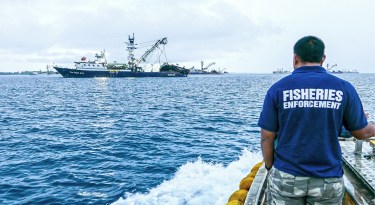
FRANCISCO BLAHA*
There is a lot written by many fisheries organizations in the world about the port state measure (PSM) — from the Food and Agriculture Organization’s PSM Agreement, to the Western and Central Pacific Fisheries Commission’s PSM Conservation Management Measure, and the Indian Ocean Tuna Commission PSM Conservation Management Measure to the Forum Fisheries Agency’s developing PSM framework.
Yet, operationally, for a country, the whole point of PSMs is to avoid the use of its ports for the unloading of fish caught in illegal, unreported and unregulated (IUU) fishing operations by vessels both foreign and domestic.
One does not need to read every word in a document with a lawyer’s loupe or sign agreements to start operations. You just start working it out in your own time and at your own pace. There is no need to have all the papers lined up and all the standard operation procedures written before you start doing something.
“Doing something” may entail fisheries authorities changing the way the port operations are conducted. Training by doing takes time, resources will need to be mobilized, routines need to be created, and so on. Many aspects of the day-to-day work cannot be foreseen by doing a one-week workshop, attending some meetings, and expecting all things to be right. You need to start, and to learn by doing — and for that you do not need to sign any high-level document.
Anyone working in compliance has learned that there is only one thing worse than not signing a piece of paper: it is to sign it and then not be able to comply with it.
All countries do understand the importance of signing on to international commitments. Still, they are also aware, on a daily basis, of the limitations faced, particularly when small countries blessed with good natural ports are taking on the job of controlling vessels.
This is a job that ought to be shared with the flag states, yet that is not always the case. For example, many port states in the western and central Pacific region inspect more vessels from distant water fishing nations (DWFN) than the vessels’ own flag state authorities do.
Yet, when you start doing PSM routinely, it pays off. The recent case of the Marshall Islands Marine Resources Authority (MIMRA) is the perfect example. In February, it charged a Korean longliner for fishing in Marshall Islands waters without a valid license. The charge was based on best PSM practices.
MIMRA’s PSM strategy focuses on intelligence analysis around the identity, licensing and operations of arriving vessels before they are authorized to use the port.
The operations part requires them to analyze the ship’s movement before it enters port. This is done by looking at its vessel monitoring system (VMS) track. It is one thing is to look at VMS track, and another to understand the behavior of a particular type of vessel based on gear deployment and maneuvering.
While VMS may give you a good indication of what happened at a time and place, sometimes it does not suffice as evidence. So, once on board, the officer needs to know what to look for and where to find it, so they can collect definitive evidence that cannot be disputed.
The types of supplementary evidence that make cases watertight include logbooks (captains’ and chief engineers’), temperature records, onboard GPS plotters, and buoy-recovery marks, among other types of vessel information.
Furthermore, the active conduct of the boarding officers shows the captains that they know their job. In most cases, captains accept this, and accept the charges to cut their losses.
And this is exactly what my colleagues in Majuro have done with the FV Oryong 721. Fisheries Officer Beau Bigler identified the offense during the maneuvering analyses that are part of the routine intelligence report prepared for every vessel intending to enter Majuro. He took notes on time and place, and once on board went straight to the bridge and collected evidence from documentation written and instruments operated by the captain, making the evidence really hard to dispute.
The charging of the vessels is a total win for the PSM team in MIMRA. It is one you get by understanding how different fishing vessels operate, and what and where information is recorded and stored on board.
Add to that the dedication of competent officers, and we have PSM that works and produces results without having to sign — for now — any big documents. Simple as that.
* The author is the Offshore Fisheries Advisor at the Marshall Islands Marine Resources Authority. His position is supported by the New Zealand Ministry of Foreign Affairs and Trade.

